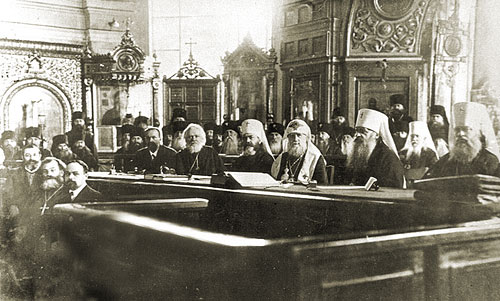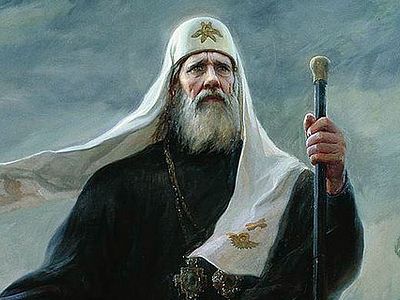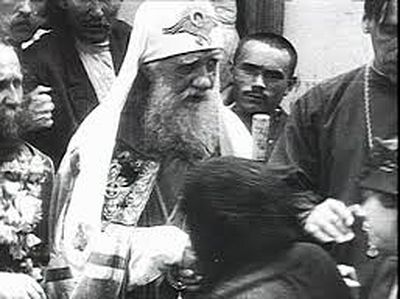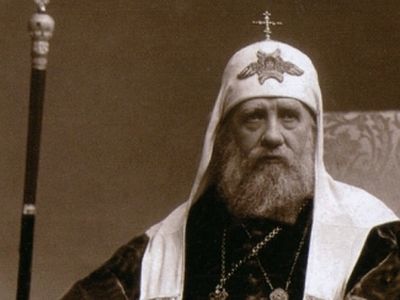Today the Russian Orthodox Church celebrates the election of St. Tikhon as the Patriarch of Moscow and All Russia. Author Mikhail Babkin discusses how this exceedingly popular and worthy Patriarch was elected, during a period of extreme upheaval.
 The Meeting of the Local Council of the Russian Orthodox Church, 1917-18.
The Meeting of the Local Council of the Russian Orthodox Church, 1917-18.
Work on the preparation for the Local Council of the Russian Church in 1917-18 went on for over ten years. The question about its convocation was accepted in as early as 1905 in connection with the need to conduct Church reforms. From that time on the higher clergy strove to one way or another free themselves from the synodal reform instituted in 1721 by Emperor Peter I.1
For preliminary review slated for consideration at the Council on January 14, 1906 the Holy Governing Synod with permission from His Highness accepted the resolution to create a special commission—the Pre-Council convention. It convened from March 6 to December 15, 1906. It worked out the recommendation of the Local Council to institute the Patriarchy, which had been dissolved by Emperor Peter I. This historical decision was accepted on June 1, 1906. Preparatory work for convoking the Council was continued also in another specially instituted Church agency—the Pre-Council meeting, which worked from February 28, 1912 to April 3, 1913. It also discussed the Patriarchy as the foundation of ecclesiastical structure.
However, Emperor Nicholas II continually put off the convocation of a Local Council. He strove to avoid any dramatic changes in the synodal format of ecclesiastical government, because any radical transformation of spiritual “authority” threatened to restructure the religious foundation of the monarchy. And this, in turn, threatened the destruction of the entire structure of an Orthodox Empire. Namely, the Patriarch’s place in the governmental structure and the relationship between the Tsar’s authority and the Patriarch’s authority was put in question. Therefore the Tsar strove to place a political “freeze” on changes to Church-State relations.
During the first days of March 1917, along with the toppling of the monarchy disappeared the main “hindrance” to the convocation of a Local Council. On April 29, 1917 the Holy Synod passed the resolution on forming a Pre-Council council, tasked with preparing questions for discussion at the “Church Constituent Committee.”
The Council began its work on June 12 of the same year. On July 5, the Holy Synod handed down a decision in its report to convene the Council in Moscow on August 15, 1917. On the same day, the “Statement on the convocation of the Local Council of the Orthodox All-Russian Church” was released. In it, among other things, the following order for election of delegations from church localities was determined.
The election process began on July 23 (Sunday), when across the entire country elections were to take place at the lowest, parish level. From every church at the “higher-level” conference of its deanery electors were nominated: 1) All the regular members of the clergy, and 2) pious laity (confessing Orthodoxy and of the male sex), two to each one member of the clergy. At this stage, as opposed to the rest, persons of the female sex could participate. From each monastery participated every tenth fully-tonsured monk, and twice that amount of monastery parishioners. Ryassaphore monks, novices, and inhabitants of women’s monasteries participated in the elections on a basis equal to the laity.
If we consider that in the Russian Empire in 1914 there were over 54,000 parish churches, around 1000 monasteries (in which lived 30,000 monastics), over 112,000 white [married] (not counting military) clergy, then we are talking definitely about a literally “all-Russian” election at the Local Council.
The deanery conferences across the Russian Church were supposed to meet on July 30. Each of them was to choose two clergymen (one of whom should be a priest) at their local diocesan electoral conferences, and three laymen. Moreover the candidates were chosen by ballot taken from any one of the electors. No more than four clergymen and six laymen could be shown. The elections were by closed ballot, and the results were decided by majority vote.
Parallel to this was the nomination at the diocesan conferences of electors from local theological educational institutions: two people from the seminary administration, and one person from the administration of women’s diocesan schools, women’s religious schools, and men’s religious schools.
The corresponding diocesan conferences were to take place on August 8 in the presence of all local bishops. The diocesan hierarch was to preside at them. From these were to come five nominees for the Local Council: two clergymen (one of whom should be of the priestly rank, and the other of any clerical rank, from bishops to readers) and three laymen. As at the deanery conferences, the candidates were chosen by ballot, on which no more than four clergymen and six laymen were to be shown. In the process of secret voting, the deciding factor was the majority vote.
Other quotas were also determined: from the army and navy clergy—ten people, from the “United Faith” Old Believers—ten, from all four theological academies—three, from the Academy of Sciences and eleven universities (Petrograd, Moscow, Kiev, Kharkov, Kazan, Novorossiisk, Saratov, Yuriev, Tomsk, Donetsk, and Perm)—one each. Fifteen spots were set apart for the Orthodox members of the State Duma and State Council. The Court clergy, in light of the fact that the sovereignty had fallen, were not given a quota. The rights of Council members were granted to representatives from Eastern Patriarchates and Orthodox autocephalous Churches.
Besides the elected members at the Local Council, present were all members of the Holy Synod, all diocesan bishops, the abbots of all four Lavras,2 the abbot of Solovki, Valaam, Sarov, and Optina Monasteries, members of the Pre-Council council, and two archpriests: of the Dormition Cathedral in the Moscow Kremlin and the of the army and navy clergy.
Altogether there were 564 members chosen and appointed to duties: 80 hierarchs (that is, approximately every second hierarch out of the total number of “regular” hierarchs of the ROC at that moment), 129 members of the priestly rank, ten deacons from the white (married) clergy, 26 readers, 20 monastics (archimandrites, igumens, and hieromonks) and 299 laymen.
The lay constituency was singularly variegated: from peasants, tradesmen and petty servants to representatives of theological sciences and top-level dignitaries. The most striking representatives of the latter were the banker and industrialist Alexander Guchkov, who from March 2 to May 2, 1917 was the military and naval minister of the Provisional Government, as well as the landowner Mikhail Rodzianko, the chairman of the State Duma. The cream of theological thought was also broadly represented. In whole, the “all-people’s elections” at the Local Council determined its “all-people’s” constituency.
The Council opened in the Dormition Cathedral of the Moscow Kremlin on August 15, on the feast of the Dormition of the Mother of God. At the places of honor among the worshippers were members of the Provisional Government: Prime Minister Alexander Kerensky, Minister of Interior Affairs Nicholai Avksentev, and Minister of Confessions Anton Kartashev.
On August 18, Metropolitan Tikhon (Belavin) was chosen as chairmen of the Council, as he was the archpastor of the city in which the ecclesiastical forum had gathered. The co-chairmen (in the language of the day, “comrade chairmen”) chosen from among the hierarchs were Archbishops Arseny (Stadnitsky) of Novgorod, and Metropolitan Anthony (Khrapovitsky) of Kharkov; from among the priests, Archpriests Nicholai Liubimov and George Shavelsky; and from among the laity, Prince Evgeny Trubetskoy and Mikhail Rodzianko.
The Council worked for over three years. During this period there were three sessions: the first from August 15/28 till December 9/22, 1917, and the second and third in 1918 January 20/February 2 till April 7/20, and from June 19/July 2 till September 7/20. The central question at the Council was about the governance of the Russian Orthodox Church. The main conclusions by those in favor of the Patriarchy and restoring this form of government boiled down to the necessity of having a single head of the Russian Church (as did other Local Churches), as well as a generally accepted “spirit-bearing guardian of our conscience, our spiritual leader.” For example, one of the zealous “Patriarchists”, bishop Mitrophan (Krasnopolsky) of Astrakhan, on October 11 called to the Council members: “We need a Patriarch as an ecclesiastical, prayerful head of the Russian Church—a representative of ascetical labor and boldness, and defender of the Russian Church. Give us a father, give us a man of prayer and ascetic laborer!”
Protest against this principle of government boiled down mainly to fear of any absolutism within Church authority (the rise of a Russian papism) and the possible contradiction between Patriarchy and the principle of conciliarity (sobornost). Namely, on October 21, Archpriest Nicholas Dobronravov (from 1921 on, a bishop) opposed, saying: “They say that the canons require a Patriarch. But we say to that that in the first three centuries there were no Patriarchs. They answer us that back then, Patriarchy was an idea, so to say, in its conceptual state at that time. But we are not discussing the world of ideas here, but the factual, real world. We are not concerned with embryonic Patriarchy. We wish to know whether there really was Patriarchy in the first three centuries. There wasn’t. It follows that the Church was able to exist without a Patriarch.”
On the whole, over the course of many days of consideration, the fate of the governance of the Russian Church was not clear. However, the discussion changed after news came from Petrograd: On the night of October 25 the Provisional Government was toppled, and on the 26th a new government was formed—the Soviet of People’s Commissars. The Bolsheviks had come to power.
Against the background of the shooting that was beginning in the streets of Moscow, which arose as a result of the anti-Soviet Junkers rebellion taking over the Kremlin, amidst the constant political wavering of various secular authorities, the opinion of the Council participants began to lean in favor of Patriarchy. On the same day, October 28, at requests from over sixty Council members, discussion on restoring the Patriarchy ceased (although there still remained ninety recorded orators). By general vote the “General statement on the higher governance of the Orthodox Russian Church” was passed. It stated: “1. In the Orthodox Russian Church the highest authority—legislative, administrative, judicial, and controlling—belongs to the Local Council, periodically convoked at specific times with a constituency of bishops, clergy, and laity. 2. The Patriarchy is restored, and the ecclesiastical government is headed by the Patriarch. 3. The Patriarch is the first among equals of the bishops. 4. The Patriarch, along with the ecclesiastical agencies of governance, is accountable to the Council.”
By acceptance of this act, Patriarchy was re-introduced into the ROC and the principle of conciliarity was declared.
On October 30, the order for choosing a Patriarch was established: 1. The Council members shall submit ballots on which each is to write one name; 2) A list of candidates shall be made based on the ballots submitted; 3) After the list is read aloud the Council shall choose three candidates by ballot, each giving three names out of the number of those shown in the list; 4) The names of the first three who have received the absolute majority of votes shall be placed on the Holy Table; 5) The election shall be made by casting lots. This is how the election of a Patriarch from only the clerical ranks was established.
After submitting ballots (there were 273 in all, but 16 turned out to be empty) the vote count gave 25 names. The leaders of the list were: Archbishop Anthony (Khrapovitsky) of Kharkov (101 votes), Archbishop Kirill (Smirnov) of Tambov (27), Metropolitan Tikhon (Belavin) (23), Metropolitan Platon (Rozhdestvensky) of Tiflis (Tbilisi) (22), Archbishop Arseny (Stadnitsky) of Novgorod (14), Metropolitan Vladimir (Bogoyavlensky) of Kiev, Archbishop Anastasy (Gribanovsky) of Kishenev, and Archpriest George Shavelsky (13 each). The rest took no more than five votes.
At the next meeting, on October 31, the procedure for electing candidates for the Patriarchy continued. The Council members were offered to submit ballots showing three names out of the number of those chosen the day before. The results gave three names—Archbishop Anthony (Khrapovitsky), Archbishop Arseny (Stadnitsky), and Metropolitan Tikhon (Belavin). That is, the candidates for the Patriarchy were all hierarchs in the ruling group within the Council.
On November 4 the election of the Patriarch was appointed to take place on the next day. The Christ the Savior Cathedral was chosen as the venue. The Dormition Cathedral at that time was not accessible because the Kremlin had been occupied by the Bolshevik regiments, which had put down the Junker rebellion.
On November 5, in the Cathedral of Christ the Savior, there was a solemn service. During the service, three paper lots (ballots) were prepared, which were placed in a small case. Afterward the case was sealed in a special manner, and taken out to the ambo.
During the service, none of the three candidates for the Patriarchy were present, waiting for word about the election. Metropolitan Tikhon of Moscow and Archbishop Arseny of Novgorod were waiting at the Holy Trinity Sukharev Metropolitan’s podvorye, and Archbishop Anthony of Kharkov was at the Valaam podvorye.
Before the reading of the Gospel in the church, the Vladimir icon of the Mother of God was brought from the Dormition Cathedral. It was placed next to the ballot case. At the end of the Liturgy a special moleben was served. After this came the ceremony of opening the case. Metropolitan Vladimir (Bogoyavlensky) of Kiev lifted the lid and blessed Hieroschemamonk Alexiy (Soloviev) to take draw one of the lots. The elder drew out a ballot and gave it to His Eminence Vladimir. The Kiev archpastor unfolded the sheet and read it, then pronounced the name of the chosen: “Tikhon, Metropolitan of Moscow. Axios!”
There is an interesting detail: on November 4, the young soviet government had barely reached a week and a half of existence. On that day the Local Council had reviewed and approved the “Rite of choosing the Patriarch of All Russia” composed by Archbishop Anastasy (Gribanovsky) of Kishinev. One of its particulars was the formula of ectenia commemoration of the new government. According to the “Rite…”, the chosen Patriarch would have to pray personally for them at the holy table of his “archpastoral” church of the Cross, directly before receiving official information of his election as Patriarch. The second prayer of the ectenia was this: “Again we pray for the God-preserved Russian Empire, its government, and for all the Christ-loving armies”. This is precisely what Metropolitan Tikhon pronounced in the altar of the Church of St. Sergius of Radonezh at the Holy Trinity Metropolitan podvorye. The uniqueness consists in the fact that this was the first (!) “official” commemoration of soviet authorities, established at the Local Council of the ROC.
On November 21, 1917, the feast of the Entry into the Temple of the Mother of God, the enthronement of Metropolitan Tikhon took place. According to the tradition of the Eastern Orthodox Churches, a thrice “seating” of the elected Patriarch was conducted. During the age of Muscovite Rus’, there was a second episcopal consecration of the bishop in the “Patriarchal rank.”
Three weeks later, on December 8, there was a council resolution worked out “On the rights and duties of His Holiness the Patriarch of Moscow and All the Russias.” In it, among other things, was stated: “The Patriarch of the Russian Church is its head hierarch. <…> The Patriarch is the first among bishops who are equal to him.” The term now in use of “First Hierarch” (предстоятелем or первосвятителем) arose several decades later.
Due to the new socio-political realities that came upon Russia from the end of October 1917, the Local Council was forced to stop its work earlier than planned. It has gone down in history for its two acts: the restoration of the Patriarchy and the election itself of the “first bishop among equals”. As opposed to all the subsequent Moscow Patriarchs of the twentieth century, His Holiness Tikhon could be rightly considered the conciliar choice of all the people for the head hierarch of the Russian Church.3



